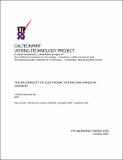The Reliability of Electronic Voting Machines in Georgia
Author(s)
Stewart III, Charles H.
Downloadvtp_wp20.pdf (248.3Kb)
Metadata
Show full item recordAbstract
Following the 2000 presidential election, the state of Georgia instituted the most comprehensive overhaul of voting technology in the country. Georgia’s actions, led by Secretary of State Cathy Cox, were precipitated by the past poor performance of Georgia’s voting machines. Although the Nation’s eyes were on Florida, a case could be made that it was Georgia that deserved the scrutiny. Georgia’s “residual vote rate,” a measure of “lost votes” that has come to be used widely to measure voting technology reliability, was 3.5% — the second worst in the country, behind only Illinois. Florida’s rate was “only” 2.9%. The best news for Georgia in 2000 was that George Bush won there handily, thus sending the national spotlight elsewhere.
Date issued
2004-10-08Publisher
Caltech/MIT Voting Technology Project
Series/Report no.
VTP Working Paper Series;20
Keywords
Electronic voting, Diebold, Georgia 2002, Residual vote